September 2025
The global metal-organic frameworks market volume was reached at 55,000.0 tons in 2024 and is expected to be worth around 3,43,966.3 tons by 2034, growing at a compound annual growth rate (CAGR) of 20.12% over the forecast period 2025 to 2034.The growing investment in MOF research and increasing applications in catalysis, carbon capture, and energy storage drive the market growth.
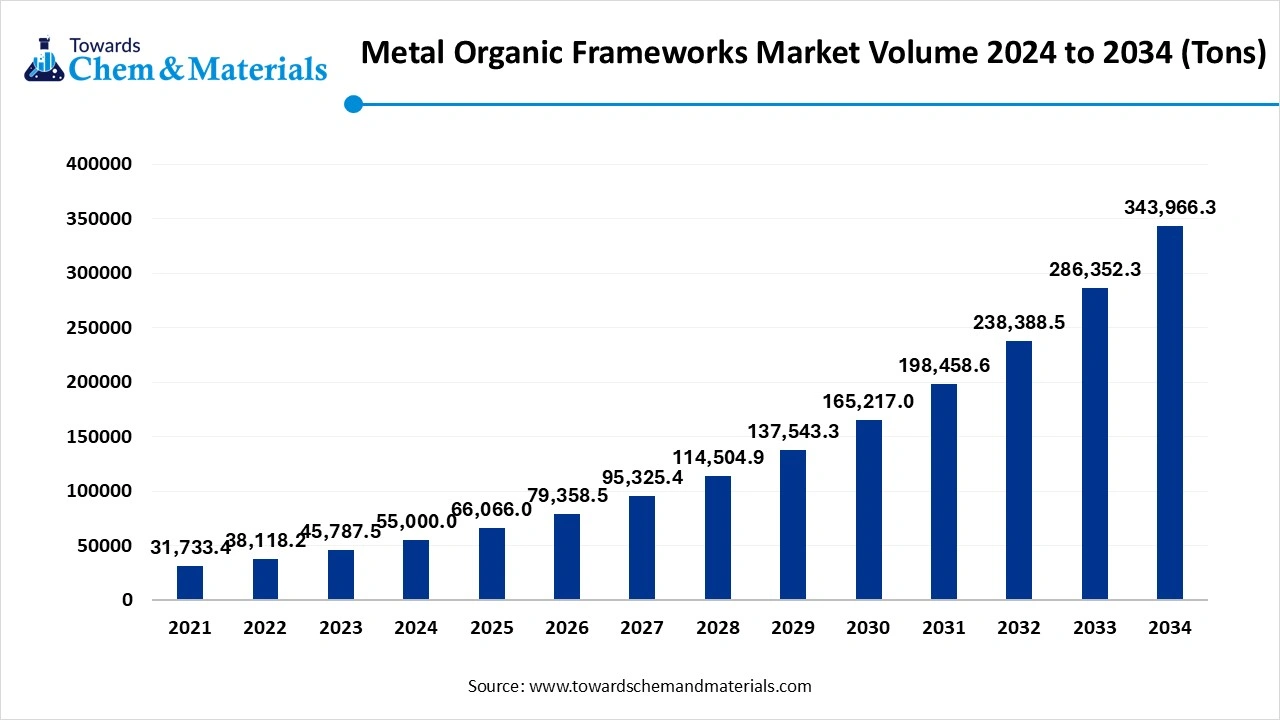
Role of MOFs in Clean Energy & Industrial Technologies
Metal-Organic Frameworks (MOFs) are crystalline porous materials made up of clusters or metal ions coordinated to organic ligands to form one-, two-, or three-dimensional structures. They possess a large surface area and store large amounts of molecules, gases, & liquids. MOF controls the chemical properties, pore size, and shape. It is highly chemically & thermally stable and acts as a heterogeneous catalyst.
The growing production of industrial gases increases demand for MOFs. The growing end-user industries like chemicals, energy storage, healthcare, and food & beverage increase demand for metal-organic frameworks. The rise in electric vehicles and renewable energy sources increases demand for MOFs for energy storage. The growing applications in catalysis, energy storage, gas separation & storage, drug delivery, and sensors contribute to the metal-organic frameworks market growth.
Growing Healthcare Sector Propels Market Growth
The growing healthcare sector in various regions increases demand for metal-organic frameworks for various applications. The focus on targeted drug delivery and the need for therapeutic agents increases demand for metal-organic frameworks. The focus on reducing the side effects of medication and improving drug efficacy fuels the adoption of MOF for drug delivery. The need for the detection of pathogens and biomolecules requires specialized sensors, which increases the demand for MOFs. The focus on diagnostics increases demand for medical imaging like MRI, which requires MOFs. The growing development of regenerative medicines and focus on tissue engineering increases demand for MOFs due to their biocompatibility. The need for hydrophilic & hydrophobic molecules in drug production increases demand for MOFs. The detection of RNA, small molecules, DNA, and enzymes requires MOFs for the development of biosensors. The growing healthcare sector is a key driver for the growth of the metal-organic frameworks market.
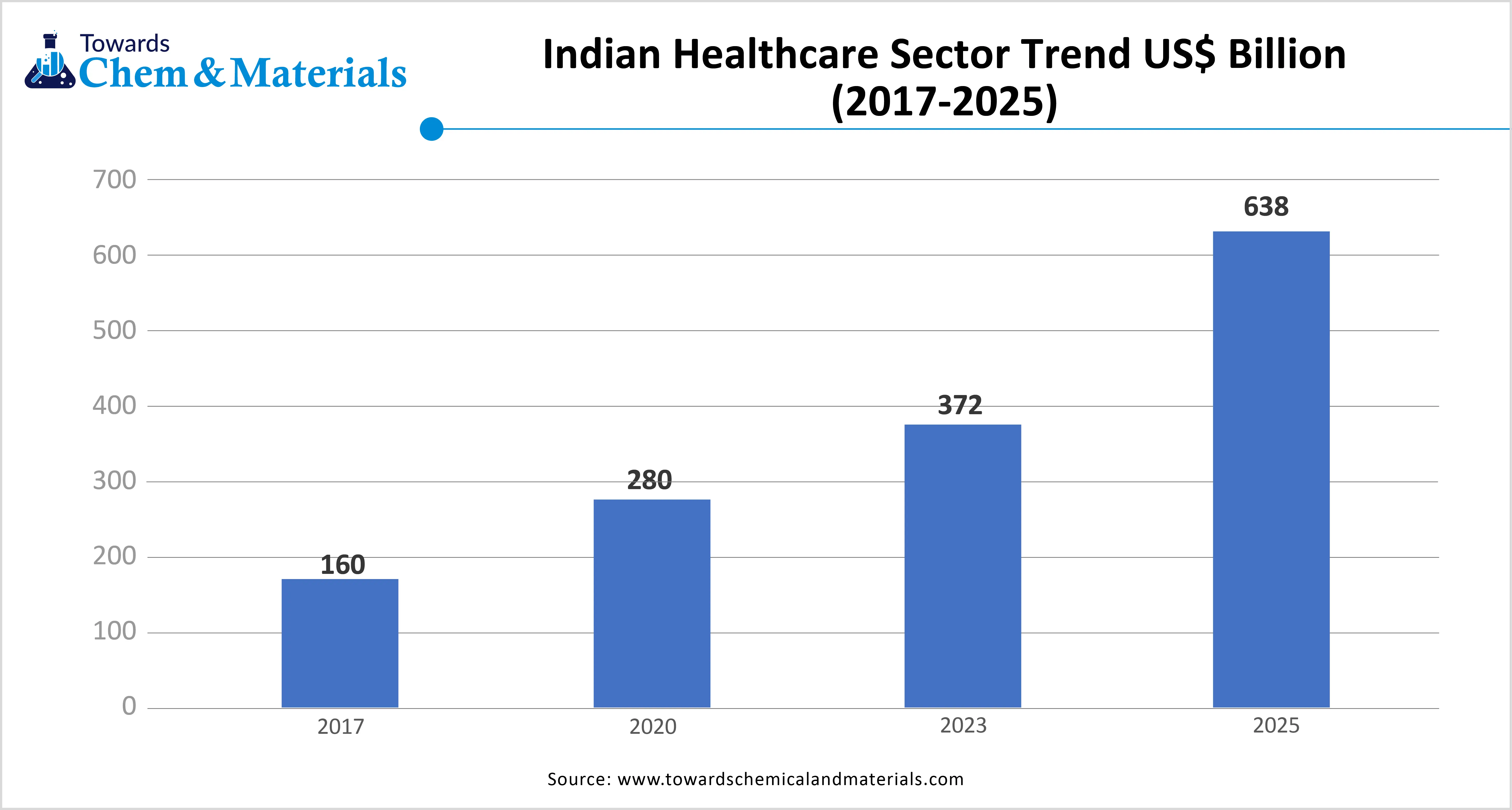
| Report Attribute | Details |
| Market Volume in 2025 | 66,066.0 Tons |
| Expected Volume by 2034 | 3,43,966.3 Tons |
| Growth Rate from 2025 to 2034 | 20.12% |
| Base Year of Estimation | 2024 |
| Forecast Period | 2025 - 2034 |
| Dominant Region | North America |
| Segment Covered | By Metal Ion, By Organic Ligand Type, By Form, By Synthesis Method, By Application, By Region |
| Key Companies Profiled | MOF Technologies Ltd., NuMat Technologies Inc,., Promethean Particles Ltd., Strem Chemicals Inc., Cambridge Isotope Laboratories, NanoResearch Elements, Research Triangle Institute (RTI International), Advanced Functional Materials Inc., Merck KGaA (Sigma-Aldrich), ACSYNAM Inc., Hangzhou FandaChem Co., Ltd., ZeoSyntha, MOFWORX, Wuhan Grand Hoyo Co., Ltd., CSIC (Chinese Academy of Sciences), Yantai Jinzheng Fine Chemicals Co., Ltd.,Shanghai Macklin Biochemical Co., Ltd., Hefei Chemjoy Polymer Material Co., Ltd., Jiangsu XFNANO Materials Tech Co., Ltd., Fujian Science and Technology Innovation Co., Ltd. |
Technological Advancements Unlock Opportunity for Market Growth
The ongoing technological advancements in metal-organic frameworks help the market growth. The technological advancements, like the manufacturing of MOF-based devices, the improvement in synthesis methods, and the enhancement of various applications, help the market growth. The growing advancements in synthetic techniques like microwave-assisted synthesis, iono-thermal method, 3D printing, and electrochemical synthesis increase applications in various sectors.
The enhancement of properties like MOF-based sensors, MOF-derived materials, conductive MOFs, MOF composites, and flexible MOFs enhances performance and functionalities. The growing development of MOF-based devices like energy storage devices & electrochemical sensors supports redox reactions and electron transport. The adoption of MOF-derived nanomaterials like phosphides, metal oxides, and carbides enhances tunable properties, stability, and conductivity. The growing technological advancements create an opportunity for the metal-organic frameworks market.
High Production Cost Shuts Down Expansion of the Market
Despite several benefits of the metal-organic frameworks in various industries, the high production cost restricts the market growth. Factors like the requirement for specialized processes & equipment, high cost of raw materials, and complex synthesis techniques are responsible for the high production cost. The expensive raw materials, like organic linkers and metal ions, directly affect the market.
The complex synthesis processes, like solvothermal synthesis and multi-step processes such as multiple purification & reaction steps, increase the production cost. The specialized equipment, like filtration systems, specialized reactors, and other requires a high initial investment. The increasing consumption of energy and energy-intensive processes increases the cost. The high production cost hampers the growth of the metal-organic frameworks market.
How North America Dominated the Metal-Organic Frameworks Market?
The North America metal-organic frameworks market Volume was estimated at 19,360.00 Tons in 2024 and is anticipated to reach 139,230.63 Tons by 2034, growing at a CAGR of 21.81% from 2025 to 2034.
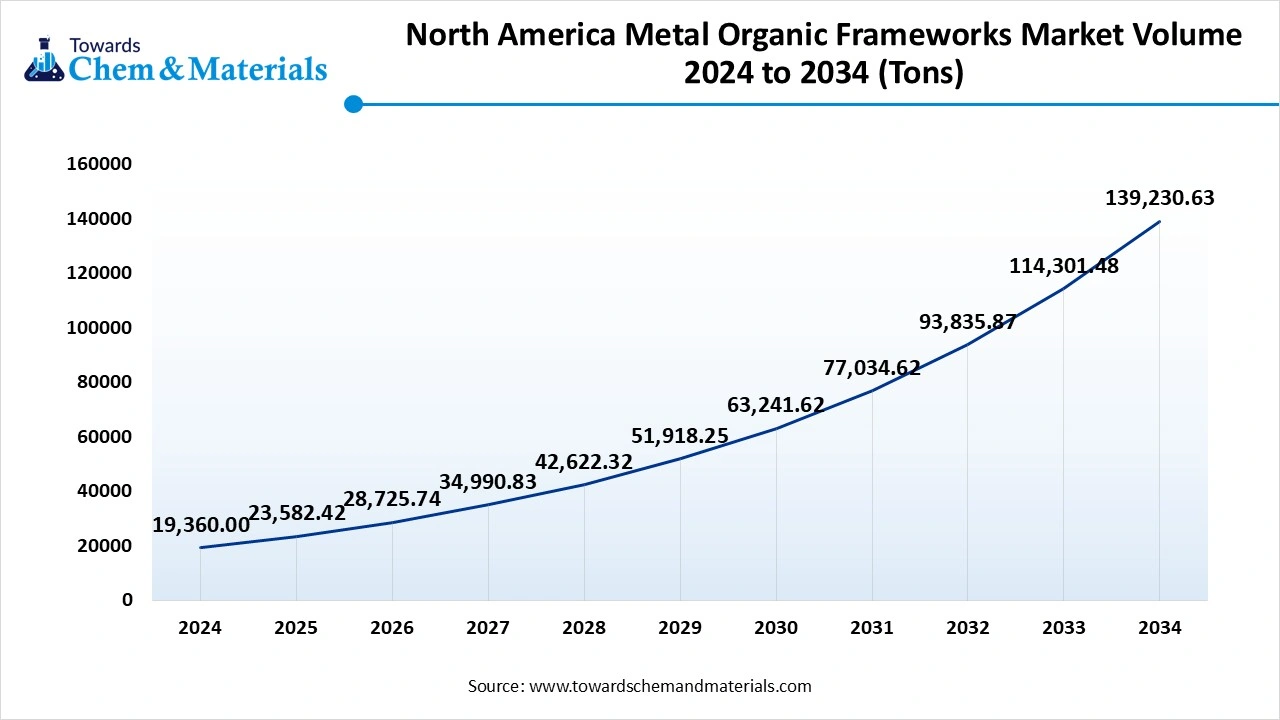
North America dominated the market in 2024. The presence of well-established manufacturing infrastructure increases the production of metal-organic frameworks. The growing MOF research and development in research institutions & universities helps the market growth. The applications like catalysis, sensing, gas storage & separation, and drug delivery increase demand for MOFs. The government focuses on the development of projects like carbon capture and hydrogen storage increases the adoption of MOFs. The extensive government support for carbon capture and clean energy fuels demand for MOFs, driving the overall growth of the market.
United States Metal-Organic Frameworks Market Trends
The United States is a major contributor to the market. The growing use of MOF in sectors like biosensing, healthcare, and pharmaceuticals helps the market growth. The strong presence of research & development and well-established manufacturing infrastructure increases the production of MOF. The focus on sustainability and stringent environmental regulations increases the adoption of MOF. The growing demand across applications like water remediation, energy storage, and gas separation supports the overall growth of the market.

Why is Asia Pacific the Fastest-Growing in the Metal-Organic Frameworks Market?
Asia Pacific is experiencing the fastest growth in the market during the forecast period. The rapid urbanization and growing industrialization in the region increase demand for metal-organic frameworks. The increasing investment in the research & development of metal-organic frameworks helps the market growth. The strong presence of abundant raw materials and a well-established manufacturing base increases the production of MOFs. The growing industrialization in countries like South Korea, China, and Japan increases demand for metal-organic frameworks. The increasing need for hydrogen energy storage fuels the adoption of MOFs. The rapid growth in sensing technologies, gas storage, catalysis, separation, and drug delivery requires MOFs, driving the overall growth of the market.
China Metal-Organic Frameworks Market Trends
China is a key contributor to the metal-organic frameworks market. The strong presence of a manufacturing base increases the production of MOFs. The presence of abundant raw materials and strong government support for the production of MOF helps the market growth. The growing applications like catalysis, environmental remediation, gas storage, and drug delivery support the overall growth of the market.
Metal-Organic Frameworks Market Volume Share, By Region, 2024-2034 (%)
| By Region | Volume Share, 2024 (%) | Market Volume - 2024 | Volume Share, 2034 (%) | Market Volume - 2034 | CAGR (2025 - 2034) |
| North America | 35.20% | 19,360.0 | 33.23% | 1,14,300.0 | 21.81% |
| Europe | 25.12% | 13,816.0 | 27.24% | 93,696.4 | 23.70% |
| Asia Pacific | 30.11% | 16,560.5 | 29.00% | 99,750.2 | 22.08% |
| Latin America | 5.34% | 2,937.0 | 5.83% | 20,053.2 | 23.79% |
| Middle East & Africa | 4.23% | 2,326.5 | 4.70% | 16,166.4 | 24.04% |
| Total | 100% | 55,000.0 | 100% | 3,43,966.3 | 20.12% |
Why did Zinc-Based MOFs Segment Dominate the Metal-Organic Frameworks Market?
The zinc-based MOFs segment dominated the metal-organic frameworks market in 2024. The growing demand for advanced biomedical materials increases the adoption of zinc-based MOFs. The applications like cancer treatment, drug delivery, and biosensing increase demand for zinc-based MOFs, helping the overall market growth. Zinc-based MOFs offer a porous structure, good chemical stability, and good thermal stability. They are affordable and widely used in large-scale industrial applications. They are produced using various methods like microwave-assisted techniques, solvothermal, and hydrothermal. The growing demand across applications like environmental remediation, catalysis, and gas separation drives the overall growth of the market.
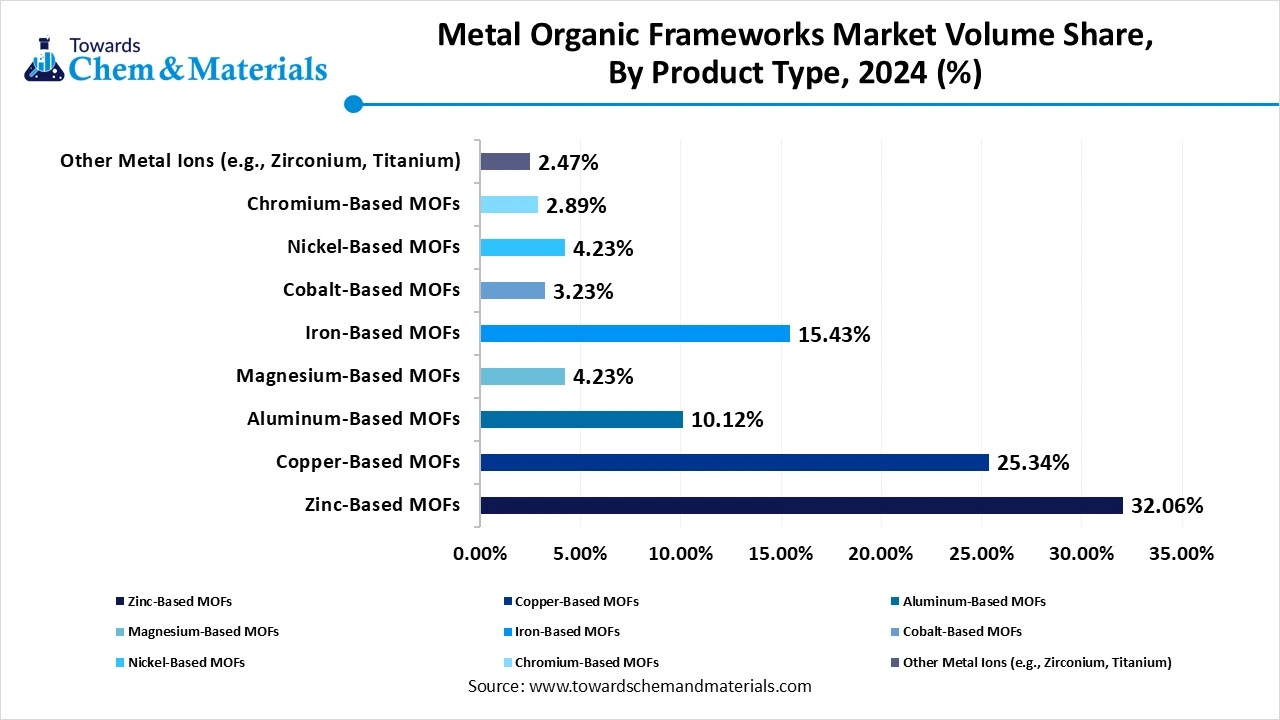
The chromium-based MOFs segment is the fastest-growing in the market during the forecast period. The growing bio-imaging applications increase demand for zirconium-based MOFs. The applications, like drug delivery and anti-cancer activity, increase demand for zirconium-based MOFs, helping the market growth. Zirconium-based MOFs consist of large surface areas and are biocompatible. It offers excellent chemical stability in water and high thermal stability. It consists of tunable pore sizes and can be easily modified using different organic linkers. The increasing demand across aqueous applications like catalysis and water purification, and the need for catalysis in electrochemical reactions and photocatalytic applications, support the overall growth of the market.
Metal-Organic Frameworks Market Volume Share, By Product Type, 2024-2034 (%)
| By Product Type | Volume Share, 2024 (%) | Market Volume - 2024 | Volume Share, 2034 (%) | Market Volume - 2034 | CAGR (2025 - 2034) |
| Zinc-Based MOFs | 32.06% | 17,633.0 | 30.02% | 1,03,258.7 | 21.70% |
| Copper-Based MOFs | 25.34% | 13,937.0 | 23.23% | 79,903.4 | 21.41% |
| Aluminum-Based MOFs | 10.12% | 5,566.0 | 11.12% | 38,249.1 | 23.88% |
| Magnesium-Based MOFs | 4.23% | 2,326.5 | 5.30% | 18,230.2 | 25.70% |
| Iron-Based MOFs | 15.43% | 8,486.5 | 14.32% | 49,256.0 | 21.58% |
| Cobalt-Based MOFs | 3.23% | 1,776.5 | 4.40% | 15,134.5 | 26.88% |
| Nickel-Based MOFs | 4.23% | 2,326.5 | 5.50% | 18,918.1 | 26.22% |
| Chromium-Based MOFs | 2.89% | 1,589.5 | 3.29% | 11,316.5 | 24.37% |
| Other Metal Ions (e.g., Zirconium, Titanium) | 2.47% | 1,358.5 | 2.82% | 9,699.9 | 24.41% |
| Total | 100% | 55,000.0 | 100% | 3,43,966.3 | 20.12% |
How Carboxylate Ligands Held the Largest Share in the Metal-Organic Frameworks Market?
The carboxylate ligands segment held the largest revenue share in the market in 2024. The growing demand across applications like separation, gas storage, and catalysis helps the market growth. Carboxylate ligands offer strong coordination bonds with bridging, monodentate, & bidentate. It provides structural integrity and stability to the MOF. It can easily be produced and enhances the hydrophilicity of MOFs. The growing demand for various MOF topologies increases demand for carboxylate ligands, driving the overall market growth.
The imidazolate ligands segment is experiencing the fastest growth in the market during the forecast period. The growing focus on flexibility in the synthesis of MOFs increases demand for imidazolate ligands. The growing demand across harsh chemical environments like wastewater treatment & catalysis increases adoption of imidazolate ligands, helping the market growth. Imidazolate ligands strongly coordinate with various metal ions and offer high surface areas. It consists of high thermal stability, controlled porosity, and high chemical stability. The growing demand across applications like catalytic reactions, drug delivery, and biosensing supports the market growth.
Which Form Segment Dominated the Metal-Organic Frameworks Market?
The powder segment dominated the metal-organic frameworks market in 2024. The growing synthesis of zirconium-based, copper-based, & zinc-based powder form MOFs helps the market growth. MOF powder offers tunable pore sizes, high porosity, and a large surface area. The growing focus on fundamental research increases demand for powder MOFs. The production of powder MOFs uses processes like hydrothermal and solvothermal synthesis. The growing demand across applications like catalysis, biomedicine, gas storage, and sensing drives the market growth.
The thin films segment is the fastest growing in the market during the forecast period. The growing applications, like sensing and catalysis, increase the production of thin films, helping the market growth. Thin films are formed using organic linkers & metal ions, and they provide exposure to active metal sites. Thin films offer portability and have controlled morphology & thickness. They can easily integrate with a wide range of substrates and devices. The growing applications like pulsed laser deposition, spin coating, electrochemical methods, atomic layer deposition, and dip coating increase demand for thin films. The increasing demand across catalysis, biomedicine, sensing, optoelectronics, and separation supports the market growth.
How Solvothermal Segment Held the Largest Share in the Metal-Organic Frameworks Market?
The solvothermal segment held the largest revenue share in the metal-organic frameworks market in 2024. The growing demand for high-quality and large crystals for various applications increases the demand for solvothermal synthesis. The growing production of various MOFs with functionalities like pressure, solvent, and temperature increases the adoption of solvothermal synthesis. This method is cost-effective and is widely used for the large-scale production of MOF. It consists of enhanced catalytic properties and is easily adapted to a wide range of solvents. The growing demand for higher yields and focus on morphology control increases the adoption of solvothermal synthesis, driving the overall growth of the market.
The microwave-assisted synthesis segment is experiencing the fastest growth in the market during the forecast period. The growing demand for faster growth of MOF crystals and nucleation increases the adoption of microwave-assisted synthesis. It minimizes synthesis time and produces higher yields of MOF product. It has better control over particle size and offers high crystallinity. It is an environmentally friendly approach and offers consistent production of MOF. The growing demand across applications, like enhancing sensing properties and improving gas adsorption, supports the market growth.
Which Application Dominated the Metal-Organic Frameworks Market?
The gas storage segment dominated the metal-organic frameworks market in 2024. The growing demand for storing different types of gases like carbon dioxide, hydrogen, and methane increases the demand for MOF gas storage. The presence of tunable pore sizes and a high surface area helps in the gas storage. The availability of efficient storage of gases helps the market growth. The growing need for safe storage of industrial gases increases the demand for MOFs. The increasing demand across applications like carbon capture for GHG emissions, hydrogen cells for fuel cells, and natural gas storage drives the market growth.
The drug delivery & biomedical segment is the fastest growing in the market during the forecast period. The increasing demand for storing a wide range of drug molecules increases the adoption of MOFs. The focus on enhancing therapeutic efficacy and lowering side effects increases demand for MOFs for drug delivery. The increasing demand for MOF for drug delivery in cancer cells helps the market growth. The focus on regenerative medicine applications and tissue engineering increases demand for MOFs. The growing development of biosensors for the identification of biomarkers & biomolecules increases the adoption of MOFs. The increasing focus on disease diagnosis and growing delivery of various drugs like gene therapy vectors, anticancer agents, and antibiotics supports the overall growth of the market.
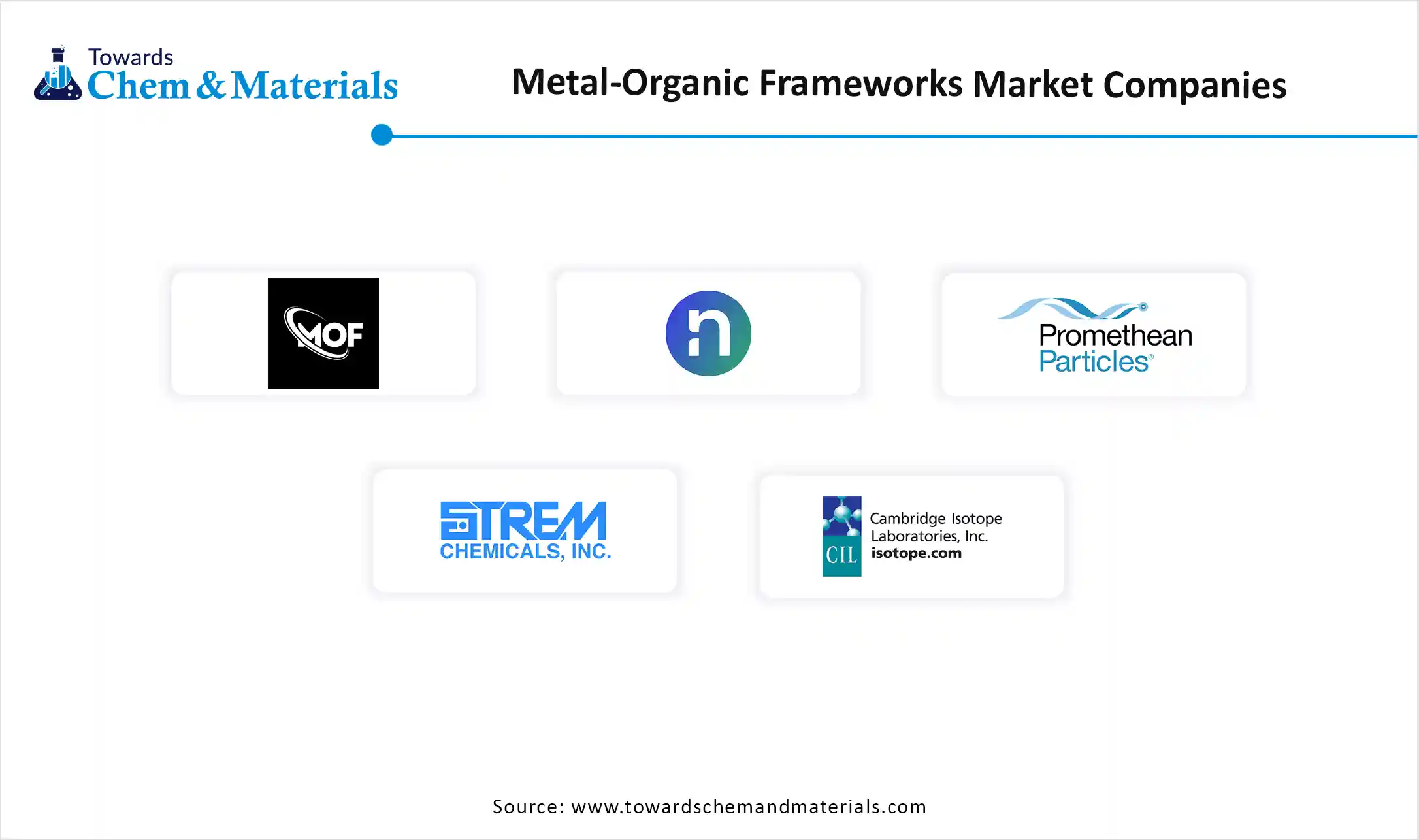
By Product Type
By Organic Ligand Type
By Form
By Synthesis Method
By Application
By Region
September 2025
August 2025
August 2025
August 2025